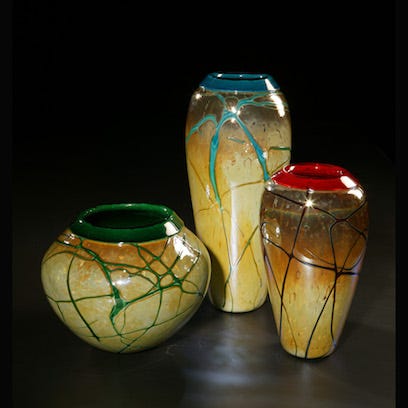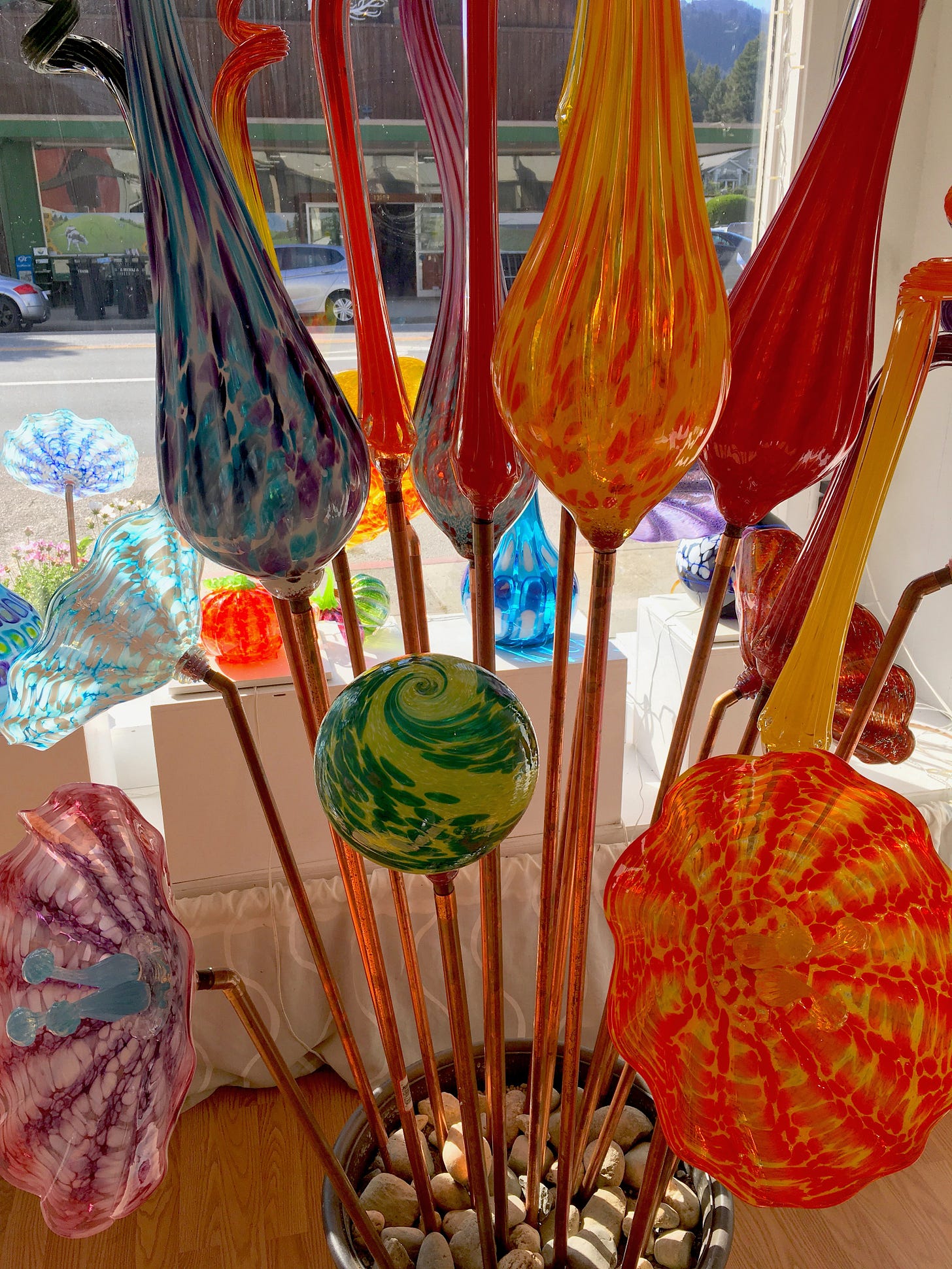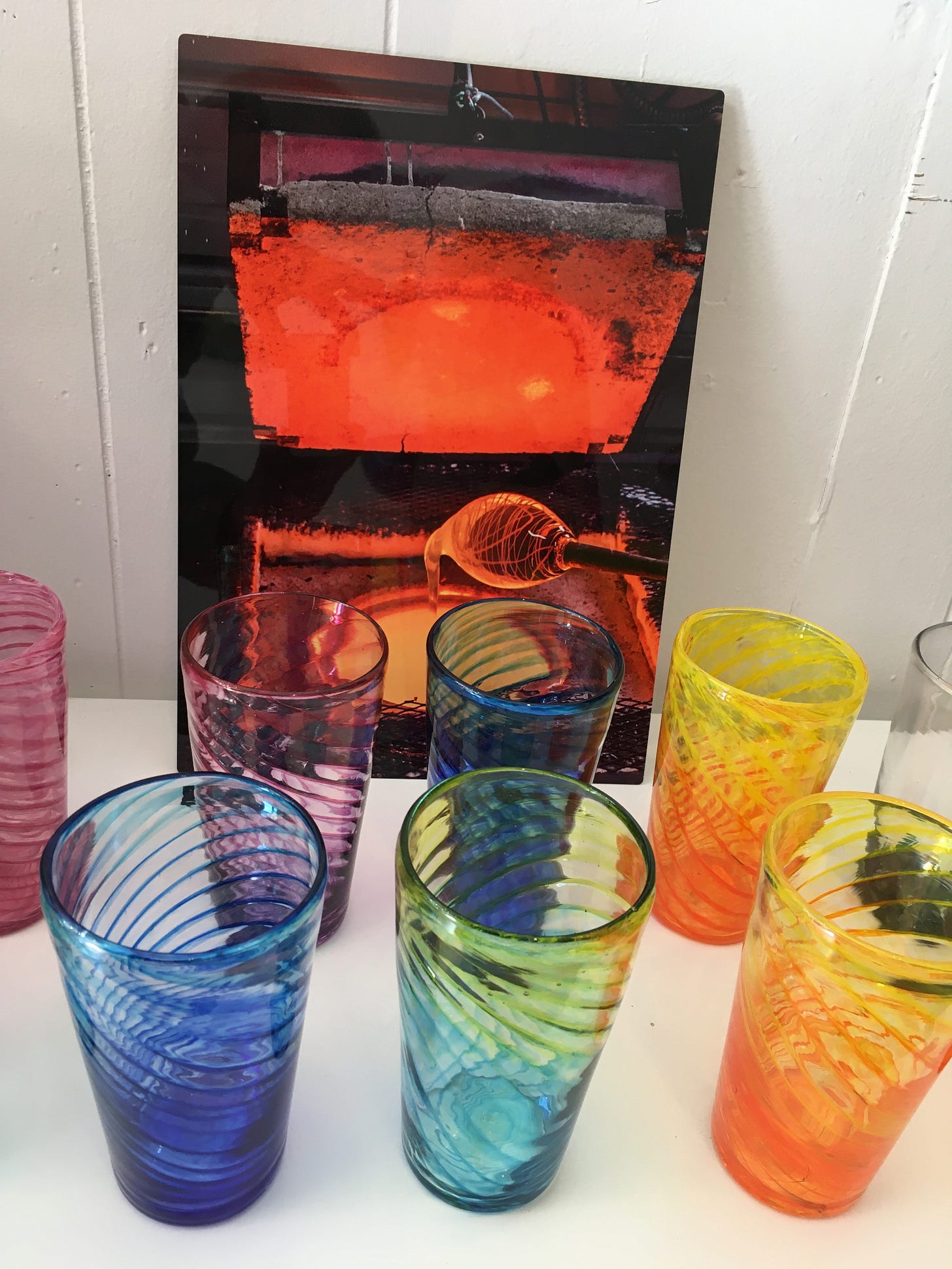VISCOSITY …
The Art Glass of Cristy Aloysi & Scott Graham—Boulder Creek, California
There’s hot air used as a creative ally, and then there’s rhetorical ‘hot air’ spouted by pompous politicians working for the club. Political gasbags aside, the glass artisans seem far more authentic in the quest for beauty and truth in the form of art and craftsmanship than political hacks who recite the prescribed narratives passed along by ideological doctrinaires. Creating color from the magical liquid seems far more practical and pragmatic than the epithets uttered by a political candidate jockeying for a citizen’s vote. When did politics become the banal sideshow of unenlightened hacks? Some historians might say that politics has always attracted certain personalities encumbered with their respective ego-centric foibles. I’m in a reflective mood as the election in November approaches—hence the introductory digression…
In terms of a practical politics, I’d suggest that the basics of resource management—which are very simple—are no longer considered seriously in the realm of entertainment distractions. Media distractions are created as if on cue and conjured by televised magicians. Having clean water or access to electricity and an open-source internet doesn’t require hours of airtime and ponderous debate, or even a Federal Government. Simplicity is blissful…
Blissful simplicity, just as creating glass requires a minimum of set-up and elemental resources—and a whole lot of practice. Heat and an acquired technical skill set are the basic requirements for successful glass-artistry. The critical detail with any artistic craftsman’s discipline has to do with apprenticeship and practice. These two factors require “access.” Access to qualified mentors, and access to the resources that one needs in order to practice and perfect a particular craftsman’s technical skill set.
Glass is in itself a complex phenomenon rooted in duality— as it is both a liquid and a solid. Scientific American reports:
“The seeming paradox that a glass is at the same time a liquid and a solid is not easily reconciled. Glasses are "solids" produced by cooling a molten liquid fast enough that crystallization does not occur at the normal freezing point. Instead, the liquid supercools into the thermodynamic never-never land of metastability: kinetically settled enough to exist as a well-defined state of matter, yet not truly thermodynamically stable. As the supercooled liquid cools to lower and lower temperatures, the viscosity of the liquid increases dramatically. That happens because as thermal energy becomes ever less available, chemical bonds within the liquid constrain the atomic motion more and more.”
“As the glass cools, the time it needs to demonstrate liquid behavior (the "viscous relaxation time") increases and eventually reaches extremes. At the so-called glass transition temperature, the relaxation time is on the order of a few minutes. On a short timescale, the "liquid" glass will appear solid, but after a short while, it can be seen to be slowly flowing, like incredibly thick syrup. At still lower temperatures, the relaxation time reaches values that are truly geologic, i.e., many millions of years. Window glass at room temperature has a nearly incalculable relaxation time, approaching the age of the universe itself. For all practical observations, this glass is a solid. But its solidity is in the eye of the beholder.”
In my perception of the global shift in human consciousness at present I might also suggest that any remaining illusions of “solidity” within the societal paradigm of yesteryear are about to turn to liquid. Definitions of reality and human identity are at the very cusp of a dramatic re-evaluation. In terms of useful creative enterprise, the artist-craftsman represents a return to the authentic value of human creativity. Artificial intelligence be damned!
Scott and Cristy’s apprenticeship story—in brief:
After their venture with “Urban Glass” in Brooklyn NY: “…the couple went on to study at the Pilchuck Glass School in Stanwood, WA., Haystack Mountain School of Crafts in Deer Isle ME., Centro Studio Vetro in Venice, Italy and Pratt Fine Art Center in Seattle, WA. Scott and Cristy have taught glassblowing at Urban Glass, Snow Farm in Williamsburg, MA, Pratt Fine Art Center and at Maho Bay on St John in the US Virgin Islands. In 2002 Scott & Cristy moved to Seattle WA…”
Then Scott and Cristy moved to Boulder Creek, California, which is where I visited the Viscosity shop. As soon as my friend and I entered the store I felt as if light was lifting me upwards—as if under the lens of colored glass. The sunlight shone through the front window illuminating the glass art— the colors were dazzling and spectacular in depth…it was visual poetry. A real candy store for the eyes. Scott was our artist zen host as we looked around and chatted about the art scene in Santa Cruz, and admired the diverse array of glassware. If I had Bill Gate’s budget I would’ve bought most of the work without hesitancy or reservation. Afterwards, I began to reflect on the time spent learning a craft—and the mastery on display in the glass art shop. Meanwhile, my friend bought a blueish glass vase with wings.
An artist-craftsman’s education lasts a lifetime. The linear thinking of the corporate treadmill doesn’t apply when art and creative expression define one’s life paradigm. Life is about exploration-curiosity-and learning,i.e., growth. I resonate with the term, “spirituality”, because it operates within a context that isn’t defined by materialistic pursuits as the sum total of a human being’s elemental truth. Thus for me—life is a spiritual experience in a material world. The current worldview that is being promoted relentlessly has to do with a small group of globalist entrepreneurs’ desire to amass more wealth and more power and in their own limited and myopic philosophical purview some type of affirmation that their egos are worthy of worship. The underlying philosophical premise of the techno-elite is antithetical to life itself. As if to cancel all culture in deference to binary coding.
If we consider an alternative Life paradigm framework (secular by definition) no religious construct is required to embrace the holistic tenets of one’s pursuit of self-awareness and spiritual/ontological development. I and many others have come to realize that creative self-expression via The Arts is the method many enlightened beings have chosen in order to reach a relative state of Nirvana. “Nirvana” for me—means: an ongoing process of relatedness in the Now, in a state of reflective awareness of one’s evolution as a conscious being. To other folks, Zen may apply. Or even a dynamic alignment with a Yoga practice—i.e., all of the above…
Many of us have been fortunate to enjoy a profound relationship with a teacher/mentor or “master teacher”—and the experience has enriched our lives in ways that transcend an area of artistic pursuit and spill over into the richness of ones life. I can speak of specifics in terms of my own personal areas of artistic pursuit and could write a lengthy treatise on the disciplines I have explored. However, I wish to speak in terms of the universalities of creative self-expression rather than focus on the generalities of a personal experience. Perhaps I am tired of the late-night talk shows with featured pop stars and movie stars entertaining the masses with personal tales of dramas and drug-rehab nightmares. The human experience is what it is—and, “ISness is our Business”— as one teacher(a swami in the Paramahansa Yogananda lineage) used to tell the congregation. I always loved that proclamation of Truth.
What is “ISness?” This is where I re-link the engine with the thought train:
Bucky Fuller referred to the “observer”—or the driver at the wheel, as the “Phantom Captain.” I see the phantom captain as the director of free will and the creative driver for one’s self-expression. Others may simply call this aspect of human experience, “God.”
I also see a possibility for human consciousness as a malleable-suggestible-mind field, with many obstacles, emotional triggers, and dramatic pratfalls along the way. Charlie Chaplin beautifully translated the tragi-comical scenarios of human life. The arts, and dramatic theatrical arts in particular, have held the mirror up to society’s face so we may witness the incredible scope and detail of the human spectacle. Writers of fiction and song lyrics, actors, and all other artists show us what it means to be human. To say we are merely “hackable animals” is a tragic and twisted indicator of a malignant thought-form embraced as truth. “Hackable” is a limited definition of what it means to be a “human being” —it doesn’t possess authentic merit as an idea or a definition rooted in Truth. This materialist’s definition is blind to the creative genius of the human mind. It also negates the value of Life as a process of Being and Becoming, to include all manner of artistic self-expression— as if all Art is merely a repetitious and redundant cycle of copy-cat behavior,e.g., “Monkey see - Monkey do.”
It’s a fact that repetition does rule in a profit-for-profit’s-sake realm; especially in the sense that in a mechanistic AI-bound society most commercial art is rendered as a fabrication and imitation of human creative genius. Many of us realize that pop music that is considered “saleable” is manufactured in accordance with a demographic metrics analysis. The truly creative singer-songwriters may shy away from the corporate music biz as they realize that the producers are more interested in marketing “product” rather than nurturing individual talent. Hence some of the most dynamic musical pioneers may never be heard by the general public. It’s an old story, told many times, and major motion pictures have repeated the tale often. The basic story model of ‘underdogs and top dogs’ rules the roost when it comes to Hollywood’s recipe for story-telling. It’s a ‘dog eat dog world’ out there in the jungle.
Art, in its purest sense, has little to do with dog fights and banal corporate profit margins. Art IS. It’s the physical evidence for human Being and Doing, and the imagination of a creative soul. Creating Art, when practiced with mindful detachment, is a conduit for self-realization and also societal reflection. It’s Zen in action.
An Artizen ought to be a label we might consider and embrace within the possibilities for human culture circa 21st century. Along with the Artizen title, I propose that we artists co-opt the A.I. acronym and translate it as— “ARTISTIC INTELLIGENCE.”
Color intelligence:
Wax On/Wax Off
The deeper value of mentorship: practice and discipline
The big “missing”, also known as a 500lb gorilla—has to do with how universities became a treadmill production plant for corporate employee prospects, or future ideologues for whatever the trending doctrine is at the time. In today’s Left-leaning institutions a Woke brand has emerged as the best way to go for humanity—even if gender ‘mutilation’ is considered normal. Never mind that genital surgery is an adjunct to a transhumanist’s desired outcome, which sounds a bit nostalgic when considering how the sultans of yore castrated their male slaves. Could the current gender mutilation scenario be a replay of ancient history? Eugenics once again—who’s DNA is allowed to replicate?
The techno-ideologues have indoctrinated students with the idea that Big Tech is superior to nature, creative endeavor, and life in general. Those of us who’ve followed the Weffer’s [The World Economic Forum and its acolytes—for the uninitiated] and their incredible pace and actions in order to take over the world, realize that they negate ‘Life as a gift.’ Human life, as anything but a programmed auto-bot non-experience, is shunned. Being happy isn’t really about being fulfilled as a Creativ, or as an artist; being happy is just a chip implant stimulating some region of the brain in order to produce a sense of euphoria. Nano-designer drugs are the key to happiness in the Weffer’s realm. Whereas, those of us Humans who regard life as a gift and as a sacred experience understand that happiness is a wave to surf. We create our own happiness when we see ourselves as the drivers at the wheel—or recognize the mystery of the Phantom Captain in charge.
Education vs indoctrination
Freedom vs ‘slaves to servitude’ is the crux of the matter at hand. Unfortunately many in an emerging generation have had much less freedom than those of us from another era. I was chatting with a woman who is working towards mastery of the ceramics medium, who is also an operatic singer-performer, and she related the following story to me: She said, that a young man told her that he wanted to “make beats.” This is the modern-day jargon for creating drum grooves via software so a beat designer might work with a rap/hip-hop performer as a collaborator. As her story unfolded, she described how the young man grew frustrated when he couldn’t get past the password firewalls needed in order to work with various software apps. In essence: Computer says, “No.”
This brings me back to what I call, “access.” In my process as a musician who studied percussion, the young beat-maker-wannabe is not free to explore what truly takes discipline and time. It’s as if he just wanted to become a beatmaker in a few hours—and voila! …Instant gratification and fame!
My percussion mentor was emphatic during my first lesson(I was in my early 20’s)—at the end of our first lesson, Chuck Memphis said to me: “Learn all of this by next week or don’t bother coming back.” I was free to choose whether to be a serious student or just a wannabe. I studied with Chuck for almost three years. And I practiced 8 hrs a day. Rent was cheap in a house shared with 7 people. I worked part-time at a record store as well. As a performer, I was fulfilled whenever I felt attuned to the musicians I performed with. I feel a sense of sadness for the young man who wants to “make beats” rather than learn the craft of a drummer and explore the magic of creating music with other musicians. Such is life in the technocratic corporate realm.
“Living” vs the pursuit of a living wage
Aka: the 20th century university plight—hours for dollars blues—and the sheepskin equals $75 grand a year…(hopefully)
Graduates of a program vs graduates of life experience
In the lingo of working class wisdom— “There’s book-smart and then there’s street-smart.” In effect: Everything I needed to know I learned in kindergarten. The sheepskin is the purported ticket to a better salary—as we were taught. Except for the detail that most college grads are burdened with student debt,.i.e., the same old dance. And many grads have found that the sheepskin doesn’t translate as $75 grand a year after all, and instead, they work as a barista serving GMO’d lattes. The selected grads of exception (who can be co-opted by the corporate sector) are rewarded with the promise of a six-figure income. Some call this a merit-based system: the best and brightest deserve the rewards of wealth and prosperity. Others call this, “entitlement.” In the lexicon of Wokeness, entitlement is errantly regarded as “inequality.” The idea of entitlement goes much deeper than this when we consider how linguistics shapes our worldview.
What has vexed this mind is how “merit” seems misconstrued along with “character” and talent. What does “merit” actually connote in the end?
Dictionary definition:
merit |ˈmerət|
noun —the quality of being particularly good or worthy, especially so as to deserve praise or reward: composers of outstanding merit.
The detail that caught my eye— “…so as to deserve praise or reward.” Okay—so one baseball player deserves say, $3.5 million/ year, whereas another ball player deserves say, $10 million/ year. ‘Deserve’ is an interesting word is it not? How many times have we heard: They really didn’t deserve such harsh treatment? And yet, in a merit-based realm—a person may deserve rewards or punishments that conform with a popular accord or agreement regarding perceived merit— or lack thereof. Who decides what has merit? If the idea of merit is merely a metric-based formula, then merit truly has no exact quantitative substance or known definition. Merit is an acceptable quantity chosen in accordance with a particular group’s paradigm. It’s subjective, and therefore, a matter of opinion.
We’ve all considered our favorite actors’ performances as worthy or unworthy of receiving the coveted Oscar. The disagreements over who should win are fodder for endless arguments over what amounts to silly nonsense that omits how much the screenwriter and director and crew contributed to the actor’s performance. Not to mention the film editor! As for the Oscar winner—merit really has little to do with the choice in the end. There are too many factors to list here, and I wish to stay on track. Suffice to say— a good movie is a good movie and a bad movie is obviously flawed, and the audience cannot be fooled most of the time.
I need a tidy ending, so I’ll conjure up a recap and return to the beginning of this philosophical tract:
The glass artistry of Scott and Cristy deserves meritorious consideration as a feast for the eyes. If you are near Boulder Creek I recommend visiting the Viscosity shop. Or consider the mail order option.
Viscosity contact info is listed below
End of Part 1
NOTES:
Apprenticeship and Craftsmanship—
skilled labor and creative ingenuity











